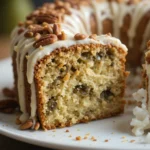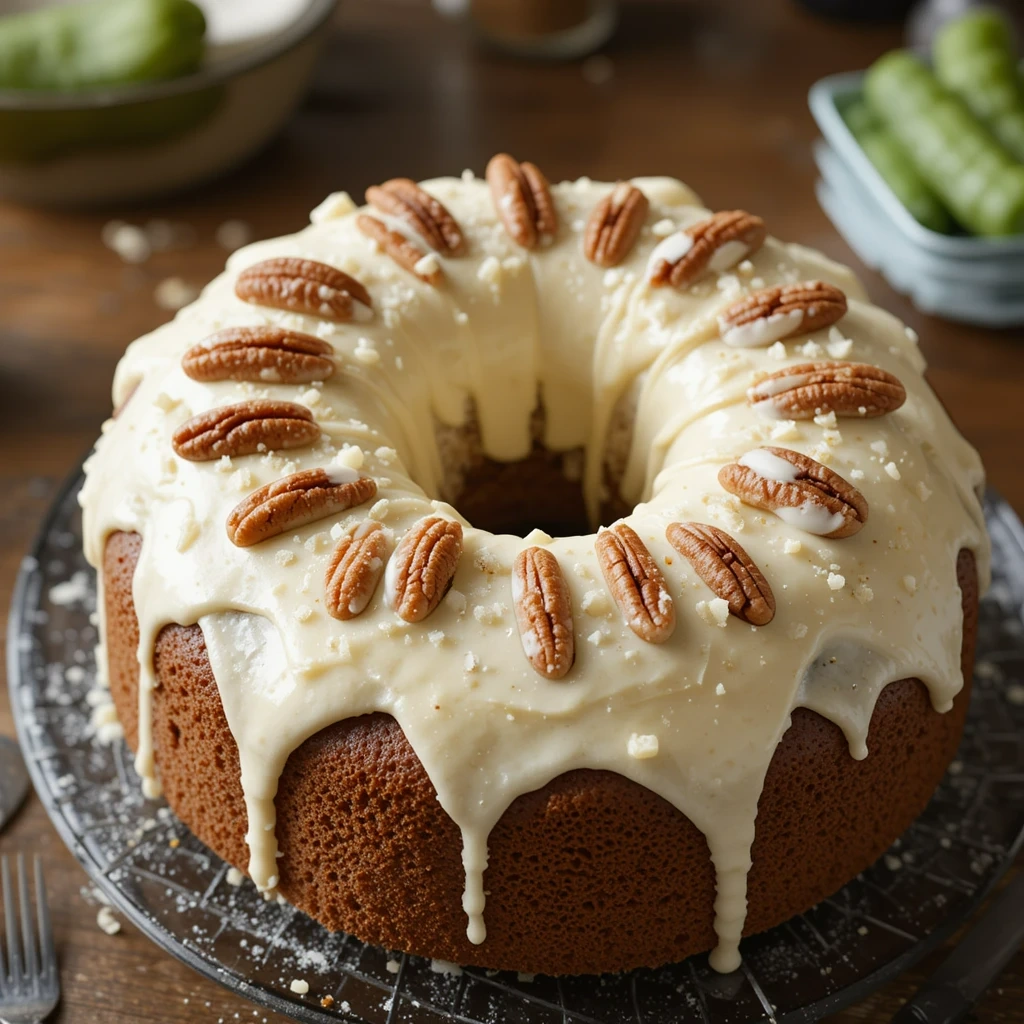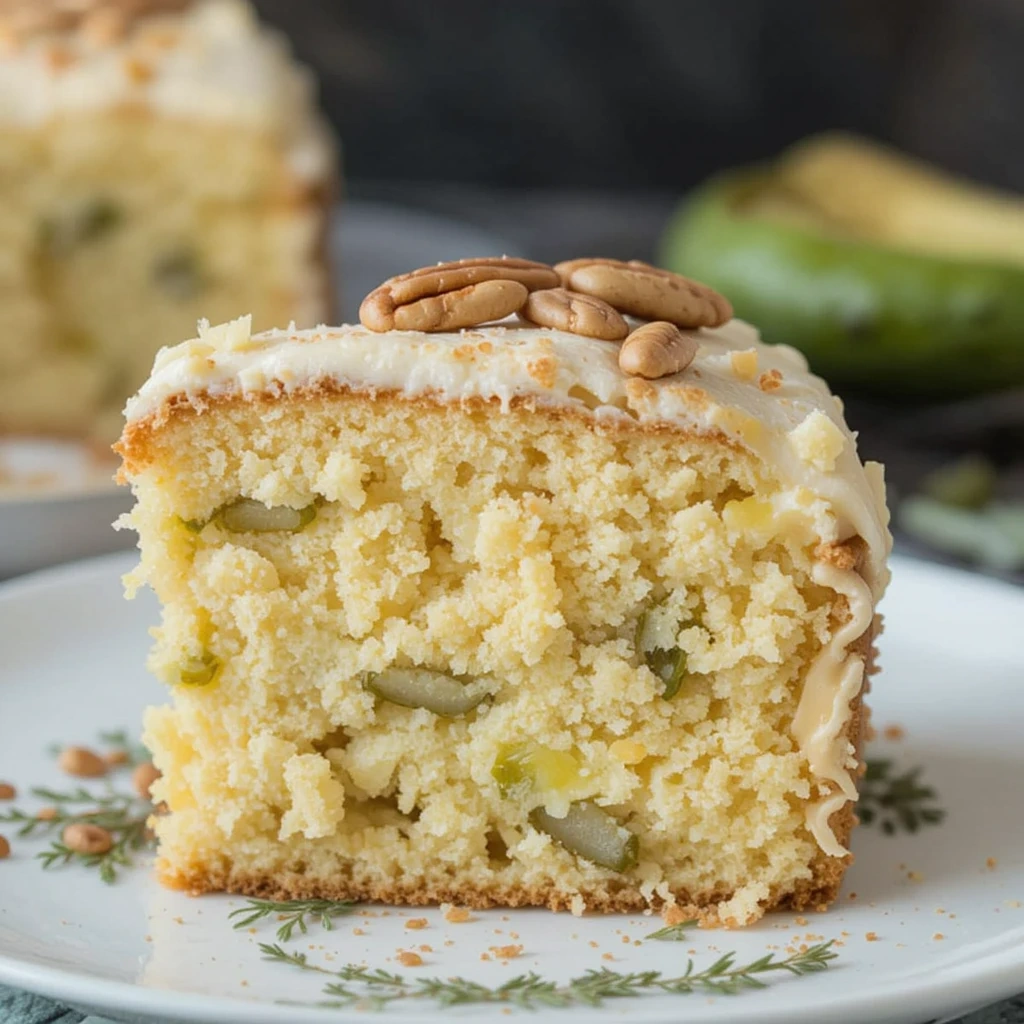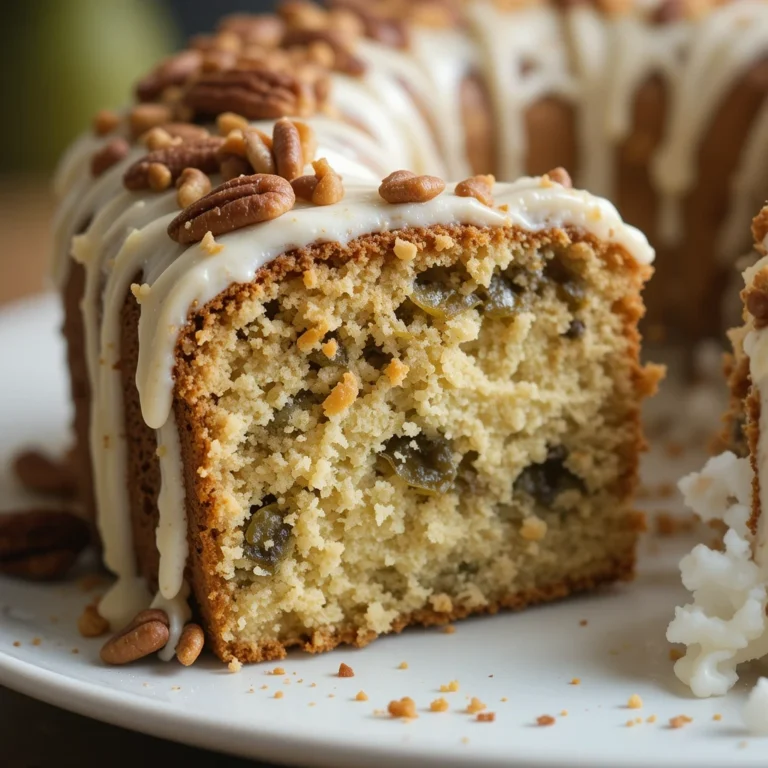Pickle cake might seem like an unusual idea at first—a sweet dessert that sneaks in the tangy brightness of pickles—but it’s actually a Southern classic with a history as rich as its flavor. I first stumbled upon this quirky recipe thanks to my grandmother, who loved to experiment in the kitchen and wasn’t afraid to blend savory with sweet. She explained how generations of families down South embraced pickle cake not just for its surprising taste, but for its moist texture and ability to transform leftover pickle juice into something truly special.
What makes Pickle Cake Recipe stand out is that perfect balance between the sharp, slightly salty tang of pickles and the comforting sweetness of cake batter, creating a uniquely satisfying bite. Whether you serve it plain, slathered with tangy cream cheese frosting, or topped with crunchy candied pecans, this cake never fails to spark curiosity and delight at gatherings—from casual potlucks to lively bake sales.
If you’re someone who enjoys stepping off the beaten path in the kitchen, pickle cake is a fun and flavorful adventure worth trying. And if you love exploring unexpected recipes, you might also enjoy diving into our Sand Cake or Banana Bread recipes—both equally inviting in their own delicious ways.
Explore this Banana Pecan Caramel Layer Cake
Table of Contents
Table of Contents

Pickle Cake Recipe
- Total Time: 60-70
Description
Pickle cake might seem like an unusual idea at first—a sweet dessert that sneaks in the tangy brightness of pickles—but it’s actually a Southern classic with a history as rich as its flavor.
Ingredients
Ingredients You’ll Need
-
- 2 cups all-purpose flour
-
- 2 teaspoons baking soda
-
- 1 teaspoon ground cinnamon
-
- ½ teaspoon ground cloves
-
- ½ teaspoon ground nutmeg
-
- ¼ teaspoon salt
-
- 1 cup granulated sugar
-
- ½ cup vegetable oil or melted butter
-
- 1 cup pickle juice (from dill pickles)
-
- 1 teaspoon vanilla extract
-
- 1 cup finely chopped dill pickles
Optional Frosting:
-
- 8 ounces cream cheese, softened
-
- ½ cup unsalted butter, softened
-
- 3 cups powdered sugar
-
- 1 teaspoon vanilla extract
-
- Candied pecans for garnish
Instructions
Step 1: Preparation (10 minutes)
-
- Preheat oven to 350°F (175°C). Grease and flour a 9×13 inch baking pan.
-
- Finely chop the dill pickles and set aside.
-
- Measure out all ingredients and have them ready to go.
Step 2: Combining Dry Ingredients (5 minutes)
-
- In a large bowl, whisk together the flour, baking soda, cinnamon, cloves, nutmeg, and salt.
-
- Make sure there are no lumps and that the spices are evenly distributed.
Step 3: Combining Wet Ingredients (5 minutes)
-
- In a separate bowl, combine the sugar, oil or melted butter, pickle juice, and vanilla extract.
-
- Mix until well combined.
Step 4: Mixing Wet and Dry Ingredients (5 minutes)
-
- Gradually add the wet ingredients to the dry ingredients, mixing until just combined.
-
- Be careful not to overmix, as this can result in a tough cake.
Step 5: Adding Pickles (2 minutes)
-
- Fold in the chopped pickles until evenly distributed throughout the batter.
Step 6: Baking (30-35 minutes)
-
- Pour the batter into the prepared baking pan and spread evenly.
-
- Bake for 30-35 minutes, or until a toothpick inserted into the center comes out clean.
-
- Let the cake cool in the pan for 10 minutes before frosting.
Step 7: Preparing Frosting (5 minutes)
-
- While the cake is cooling, prepare the cream cheese frosting.
-
- In a large bowl, beat together the softened cream cheese and butter until smooth and creamy.
-
- Gradually add the powdered sugar, mixing until well combined.
-
- Stir in the vanilla extract.
Step 8: Frosting and Serving (5 minutes)
-
- Once the cake has cooled, frost it with the cream cheese frosting.
-
- Garnish with candied pecans, if desired.
-
- Slice and serve.
- Prep Time: 30-40
- Cook Time: 30
- Category: Cake
- Method: Bake
- Cuisine: American
Why Pickle Cake Recipe Is Surprisingly Delicious
Pickle Cake Recipe challenges conventional dessert norms, offering a unique flavor and texture profile that sets it apart from other cakes. Here’s why this recipe is worth trying:
Moist and Tender Texture: The magic of Pickle Cake Recipe lies in its exceptional moisture. The addition of pickle juice and finely chopped pickles infuses the cake with moisture, resulting in an exceptionally tender crumb. Unlike some cakes that can be dry or crumbly, pickle cake remains soft and moist, even after several days. This makes it a perfect choice for those who appreciate a cake that melts in your mouth.
Intriguing Flavor: Don’t let the thought of pickles in a cake scare you away! The tangy and slightly salty notes from the pickles complement the sweetness of the cake, creating a balanced and surprisingly complex flavor profile. The subtle sourness cuts through the sweetness, preventing the cake from becoming overly cloying. This intriguing combination of flavors is what makes pickle cake so addictive.
Unexpected Combination: Pickle Cake Recipe is a conversation starter, piquing curiosity and surprising those who are hesitant to try it. This element of surprise adds to the cake’s appeal, making it a memorable and unique dessert.
Versatile: This cake can be adapted to suit different tastes by adjusting the type of pickles used, adding spices, or experimenting with different frostings. Whether you prefer dill pickles, sweet pickles, or bread and butter pickles, each type will impart a distinct flavor to the cake.

The Science Behind the Perfect Pickle Cake Recipe
Pickle cake’s unique flavor and texture are the result of a fascinating interplay between its ingredients. Here’s what makes this recipe successful:
Pickle Juice: Provides moisture and tanginess, while also reacting with the baking soda to create a light and airy texture. The acid in the pickle juice helps to activate the baking soda, creating carbon dioxide bubbles that leaven the cake.
Finely Chopped Pickles: Add moisture, texture, and a subtle pickle flavor that is evenly distributed throughout the cake. The pickles also contribute to the cake’s overall tenderness, preventing it from becoming tough or dry.
Spices: Cinnamon, cloves, and nutmeg enhance the cake’s warmth and complement the pickle flavor. These spices create a cozy and inviting aroma that adds to the cake’s appeal.
Fat (Oil or Butter): Adds richness and tenderness to the cake, while also helping to balance the tanginess of the pickles. Whether you choose to use oil or butter, the fat content is essential for creating a moist and flavorful cake.

Pickle Cake Recipe
Ingredients You’ll Need
- 2 cups all-purpose flour
- 2 teaspoons baking soda
- 1 teaspoon ground cinnamon
- ½ teaspoon ground cloves
- ½ teaspoon ground nutmeg
- ¼ teaspoon salt
- 1 cup granulated sugar
- ½ cup vegetable oil or melted butter
- 1 cup pickle juice (from dill pickles)
- 1 teaspoon vanilla extract
- 1 cup finely chopped dill pickles
Optional Frosting:
- 8 ounces cream cheese, softened
- ½ cup unsalted butter, softened
- 3 cups powdered sugar
- 1 teaspoon vanilla extract
- Candied pecans for garnish
Detailed Step-by-Step Instructions
Step 1: Preparation (10 minutes)
- Preheat oven to 350°F (175°C). Grease and flour a 9×13 inch baking pan.
- Finely chop the dill pickles and set aside.
- Measure out all ingredients and have them ready to go.
Step 2: Combining Dry Ingredients (5 minutes)
- In a large bowl, whisk together the flour, baking soda, cinnamon, cloves, nutmeg, and salt.
- Make sure there are no lumps and that the spices are evenly distributed.
Step 3: Combining Wet Ingredients (5 minutes)
- In a separate bowl, combine the sugar, oil or melted butter, pickle juice, and vanilla extract.
- Mix until well combined.
Step 4: Mixing Wet and Dry Ingredients (5 minutes)
- Gradually add the wet ingredients to the dry ingredients, mixing until just combined.
- Be careful not to overmix, as this can result in a tough cake.
Step 5: Adding Pickles (2 minutes)
- Fold in the chopped pickles until evenly distributed throughout the batter.
Step 6: Baking (30-35 minutes)
- Pour the batter into the prepared baking pan and spread evenly.
- Bake for 30-35 minutes, or until a toothpick inserted into the center comes out clean.
- Let the cake cool in the pan for 10 minutes before frosting.
Step 7: Preparing Frosting (5 minutes)
- While the cake is cooling, prepare the cream cheese frosting.
- In a large bowl, beat together the softened cream cheese and butter until smooth and creamy.
- Gradually add the powdered sugar, mixing until well combined.
- Stir in the vanilla extract.
Step 8: Frosting and Serving (5 minutes)
- Once the cake has cooled, frost it with the cream cheese frosting.
- Garnish with candied pecans, if desired.
- Slice and serve.
Pro Techniques for Success Pickle Cake Recipe
- Use good quality dill pickles for the best flavor. Opt for pickles that are crisp, flavorful, and not overly sour or sweet. The quality of your pickles will directly impact the overall taste of the cake.
- Finely chop the pickles to ensure they are evenly distributed throughout the cake. This will prevent large chunks of pickles from overwhelming certain bites and ensure a consistent flavor throughout.
- Don’t overmix the batter, as this can result in a tough cake. Overmixing develops the gluten in the flour, leading to a dense and chewy texture. Mix the wet and dry ingredients until just combined.
- Let the cake cool completely before frosting. Frosting a warm cake can cause it to melt and slide off. Allowing the cake to cool completely ensures a stable base for the frosting.
Expert Tips for Flawless Results
- Use room-temperature ingredients for better mixing and a more even texture. Room-temperature ingredients emulsify more easily, resulting in a smoother batter and a more evenly baked cake.
- Measure the pickle juice accurately to ensure the correct moisture balance. Too much pickle juice can result in a soggy cake, while too little can make it dry. Use a liquid measuring cup for accurate measurements.
- Add a tablespoon of cocoa powder to the dry ingredients for a chocolatey twist. This will add depth and complexity to the flavor of the cake.
- Experiment with different types of pickles, such as sweet pickles or bread and butter pickles, for a unique flavor variation. Each type of pickle will impart a distinct flavor to the cake.
Frequently Asked Questions About Pickle Cake Recipe
Can I use a different type of flour?
While all-purpose flour is the standard choice for Pickle Cake Recipe, offering a balance between structure and tenderness, you can experiment with other flours to achieve slightly different results. Cake flour, with its lower protein content, will yield an even more tender and delicate crumb, making the cake almost melt in your mouth. However, avoid using bread flour, as its high protein content will result in a tougher, chewier texture that detracts from the cake’s intended lightness. If you’re looking to add a nutty flavor, you can substitute up to 1/4 of the all-purpose flour with almond flour.
Can I make this cake ahead of time?
Absolutely! Pickle cake is a great make-ahead dessert, as its flavor often improves after a day or two. To prepare it in advance, bake the cake as directed and let it cool completely. Once cooled, wrap it tightly in plastic wrap or store it in an airtight container at room temperature. The cake can be stored this way for up to two days. For optimal freshness, frost the cake just before serving, as the frosting can sometimes become slightly sticky if stored for an extended period.
Can I freeze this cake?
Yes, you can freeze pickle cake for longer storage. To freeze, bake the cake and let it cool completely. Wrap it tightly in plastic wrap, ensuring all surfaces are covered to prevent freezer burn. For added protection, wrap the plastic-wrapped cake in a layer of aluminum foil. The unfrosted cake can be frozen for up to 2 months. When ready to serve, thaw the cake overnight in the refrigerator. Once thawed, frost as desired and enjoy.
What can I substitute for pickle juice?
If you find yourself without pickle juice, don’t worry – there are several substitutes you can use. For a similar tangy flavor, mix equal parts white vinegar and water. Alternatively, buttermilk can add a subtle tang and richness.
Final Thoughts
Pickle Cake Recipe is an unexpected delight that will surprise and impress your friends and family. With its moist texture, intriguing flavor, and easy preparation, it’s a perfect addition to any baking repertoire.
So, the next time you have leftover pickle juice, don’t throw it away! Use it to create this unique and delicious cake that will have everyone asking for the recipe.
For more adventurous baking ideas, consider trying our Easter Candy or Angel Food Protein Cake next!

